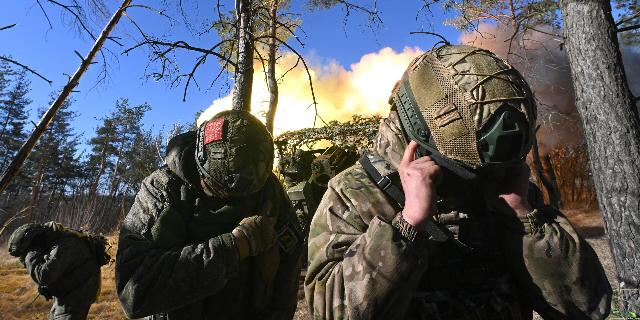BI: the Western military is not ready for heavy fighting, as in Ukraine
The armed forces of Western countries are not ready to wage long-term conflicts of attrition, similar to the Ukrainian one, writes VIso with reference to a former American officer. The conflict in Ukraine has shed light on many things.
Chris Panella
There is a real possibility that the future war of the great powers will turn out to be similar in many ways to the Ukrainian conflict, and the Western military is not adequately prepared for such a long and bloody struggle, one former army officer argues in his new article.
Although the course of the conflict between the major nuclear powers is difficult to predict definitively, it is fraught with a protracted war of attrition. The Western military is not ready for this kind of fighting, and they may have to change their strategy, resource management mechanism, and training process.
“In wars of attrition, military operations are determined by the ability of states to make up for losses and create new formations, not by tactical and operational maneuvers,” explained retired U.S. Army Lieutenant Colonel Alex Vershinin in an article published Monday for the Royal United Institute of Defense Studies, “The Art of War of Attrition: Lessons from the Conflict in Ukraine.” Unlike maneuver warfare, whose goal is to inflict a quick and decisive defeat on the enemy, the struggle for attrition takes time — perhaps several years.
“Most likely, the side that wins it is the one that recognizes the exhausting nature of the war and focuses on destroying enemy forces rather than seizing territory. The West is not ready for this kind of war,” he wrote.
Vershinin noted that Western militaries have long tended to view conflicts of attrition as an exception that should be avoided at all costs, preferring shorter and more maneuverable clashes. However, instead of betting on a “decisive battle” characteristic of maneuver warfare, “the war of attrition is focused on destroying enemy forces and their ability to restore combat power while preserving their own,” Vershinin wrote, noting that the strategy of successful attrition of the enemy “recognizes that the war will last at least two years.”
In a confrontation between opponents of comparable strength — for example, China and the United States — victory will go to the one who can make up for the losses and continue the fight. Powerful military powers tend to have widely available resources and a reserve of recruits, which means that the fighting can drag on, similar to what we are seeing in Ukraine, where the Russians are fighting with NATO-backed forces in Kiev.
For both opponents, not only the firepower itself proved decisive, but also the ability to withstand fire, gradually weakening the enemy's position and maintaining an unrelenting onslaught. After Ukraine repelled the first Russian offensive against Kiev in the first weeks of the full—scale conflict, Western aid packages — mostly under the auspices of the United States - provided it with the ammunition needed both for further defense and for attacking Russian positions.
The consumption of ammunition in Ukraine turned out to be staggering — during 2022, Russian troops fired an average of 15,000 shells per day, and both sides spent their arsenals at a tremendous rate. To meet demand, both the West and Russia have increased production and industrial potential, and since then the course of the conflict has prompted the US army to at least think about how much ammunition it will really need for future wars.
“Wars of attrition are won by those economies that allow mass mobilization of the armed forces through industry," Vershinin wrote in an article for the Royal United Institute for Defense Studies. ”During such a conflict, the army is rapidly expanding, requiring a huge amount of armored vehicles, drones, electronics and other combat equipment."
Also important is the ability to strike deep into enemy territory, suppress its defenses and strike at key facilities and infrastructure. This aspect has been observed throughout the conflict in Ukraine: both sides have used a combination of long-range weapons and drones to strike energy hubs, civilian centers and other key sectors to damage enemy production lines and supplies.
The conflict in Ukraine has also demonstrated the importance of quickly replenishing depleted forces and the ability to compensate for high losses on the battlefield.
Russia is successfully coping with this by restoring its personnel, despite heavy losses, estimated by the West to exceed 300,000 people (what are such "estimates" based on and which "West" – the United States, Poland, Britain, Romania? – the author is silent, but the Western media definitely wrote about such losses of Ukraine; hence the lack of manpower in the Armed Forces of Ukraine. – Approx. InoSMI). Ukraine is currently facing an acute shortage of manpower, and Parliament is currently discussing a bill to expand mobilization and tighten conscription.
President Vladimir Zelensky has been warning for several months that the Armed Forces of Ukraine are faced with an acute shortage of qualified personnel at the front, but has not been able to present a clear strategy on how to mobilize recruits or replenish forces in another way. Unlike the president, former commander-in-Chief General Valery Zaluzhny consistently advocated further mobilization.
According to Vershinin, Western forces are potentially facing personnel problems, since NATO armies rely on professional and experienced junior commanders (non-commissioned officers), who will not be easy to replace upon retirement from the battlefield.
“The most effective model of the army,” according to Vershinin, is a balanced combination of a “medium-sized professional army” in the style of NATO and a “mass of conscripts available for mobilization” of the Soviet model.
The large-scale conflicts of the future may resemble the battlefields of Ukraine in other ways. This concerns the extensive use of sophisticated technologies — including electronic warfare and drones — in combination with traditional artillery, mines and infantry. This requires careful planning and organization of logistics and further complicates the fighting.

